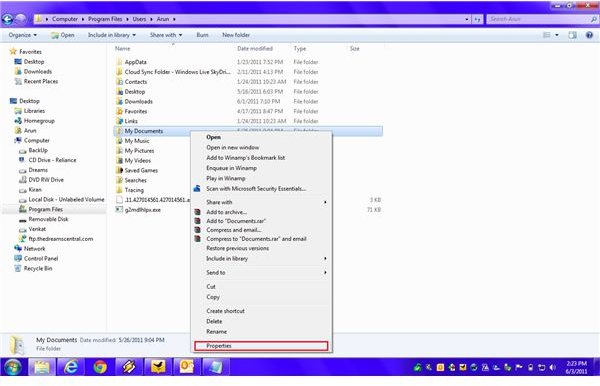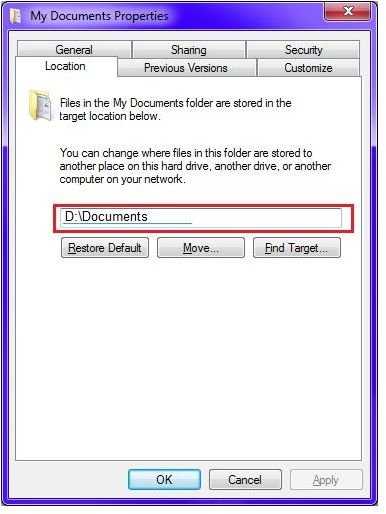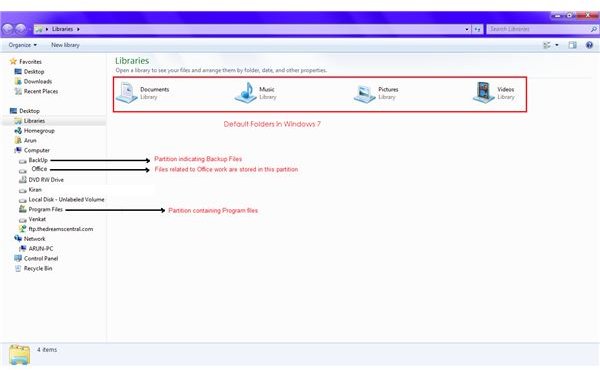Learn How to Organize the Files onYour Hard Disk for Quick Access
Windows Default File Management
Windows has its own file management system, which is created when you install the operating system. Windows XP creates the My Documents folder for your data files and Program Files folder for storing the files related to applications you install. My Document contains sub-folders My Music, My Pictures etc so that you can store the related files in these folders. Windows 7 offers you four Libraries by default: Documents, Music, Pictures, and Videos. You can store related files in these Libraries and create your own custom Libraries for files of other types. The libraries also allow you to store references to the actual files instead of physically storing your important files there.
Drawbacks of the Default Windows File System
The My Documents folder in XP and Libraries in Windows 7 are created on the system partition. The system partition refers to the hard disk partition where you install the operating system.
The default system for storing files in Windows is good, but the folders are created on the system partition. I would not recommend storing important data in these folders unless you have a good backup system in place. Things can go wrong anytime and you may have to reinstall Windows. When you reinstall Windows, the operating system will remove the previous default folders and replace them with fresh ones. This will cause you to lose data if you did not back it up recently.
It is better to reserve an entire partition for Windows and keep at least one different partition to store the data that you wish to keep secure. The Windows installation package affects only the system partition, where it stores files pertaining to Windows and files related to the programs you install. Your data on a different partition remains unaffected when you reinstall Windows.
- Create different partitions for each operating system you have.
- Use the Windows OS partitions only to install Windows and programs.
- Add at least one extra partition for storing your data (documents, templates, Outlook PST files, spreadsheets, and media files etc.).
Change the Path of My Documents Folder to A Different Partition
You can easily change the location of My Documents folder in Windows so that when you reinstall the operating system, the contents in the folders and subfolders are not lost.
To change the path of My Documents, right click on the folder and in the context menu that appears, select Properties.

In the dialog box that appears, select the Location tab and type in a new path for the folder. This new path should be a new partition such as D:\ or E:\ so that the My Documents folder is moved to that partition and is safe when you reinstall the Windows OS.

Click on OK to close the dialog.
Note that for Windows XP, when you change the My Documents folder, you automatically change the paths of My Music, My Pictures etc as the latter are subfolders of the My Documents folder.
If you are using Windows 7, you have to change the location of each folder - My Documents, My Pictures, My Videos, My Music - individually. You can locate these folders under <Drive_Letter:>\Users\<User_Name>. For example, if your Windows installation is present on C drive and your user name is Arun, you can locate the My Documents and other related folders at C:\Users\Arun.
The above helps you save contents of My Documents and other default Windows folders when you reinstall the operating system. Also note that when you reinstall it, Windows will again create these folders on the system folder. Use the same method mentioned above to point the new folders to the existing ones.
Organizing Your Data in Windows For Quick Access
The following tips may help you in better organizing your files and folders.
A. Use Folders and Sub Folders Liberally
Under Windows Installation, you can create as many folders as you wish. Once you identify where to save your business files, think of how to arrange files so that you remember them easily. For example, if yours is a business entity, the first things that will come to your mind are clients, papers like quotations, letters, invoices, etc. Create a folder and name it Clients. Under Clients, you can create subfolders Quotations, Invoices, and Other Communication.
Windows allows you to use lengthy file/folder names, so you can make good use of it. Under Invoices, you can have a folder named 2009, and in it, you can create 12 folders for each month. This is just an idea. You’ll discover what suits you best as you use your file system, and moving, copying, renaming, and deleting folders is pretty painless when you want to change something.
B. Mark Important Folders/Files by changing their Icons
You get a number of icon options when you right click on a folder, select Properties, and then Change Icon. If you cannot find a relevant icon, there are several programs available on the Internet that can create customized icons for you. Make sure you are downloading a good program, free of any malicious code. The idea is to use icons that immediately inform you about the contents of any folder. You can create icons using images of artists to quickly organize music folders, or corportate logos to identify work regarding a given client or supplier.
C. Create a Toolbar on Windows Taskbar
Create a folder named Shortcuts anywhere other than the system partition. Right click inside this folder and create shortcuts to all the folders that you access regularly. Once you are done, right click on the Windows Taskbar and select Toolbar. In the menu that opens, click on the last item saying New Toolbar. This will give you a window where you can select the Shortcuts folder. You can access the desired folder or file from the Windows Taskbar directly.
D. Finally, Backup all your Important Files
Instead of traditional backups to DVDs or external HDDs, I recommend using an online storage. Some managed remote backup services such as Mozy offer you 2GB free space. You can buy more space if you need it.
This is how I go about maintaining a filing system. If you have any ideas for organizing files and folders for quick access, please share them with us using the comments feature.
References
Screenshot of Windows 7 Explorer by author
Courseware from Aptech for A+ Certification, https://aptech-education.com/
Tips are based on authors own style of organizing his files
